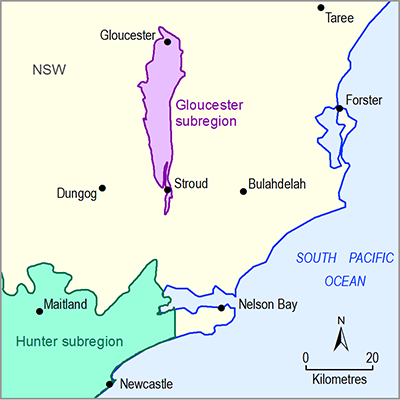- Home
- Assessments
- Bioregional Assessment Program
- Gloucester subregion
- 3-4 Impact and risk analysis for the Gloucester subregion
- 3.5 Impacts on and risks to water-dependent assets
Summary
Ecological water-dependent assets
The potential for impacts on ecological assets associated with riverine landscape classes is assessed as very unlikely (less than 5% chance), although there is large uncertainty surrounding the receptor impact modelling on which this assessment is based. There is some potential for impacts on ecological assets associated with groundwater-dependent ecosystem (GDE) landscape classes, although median estimates of areas impacted are less than 100 ha. Assets with extensive areas (e.g. habitat (potential species distribution) of the regent honeyeater) are more likely to be identified as potentially impacted because there is greater likelihood they will intersect an area of hydrological change exceeding given thresholds. However the magnitude of the impact, if any, is uncertain; it will depend on local-scale factors, including whether or not the species associated with the asset is actually present in the ‘at risk’ area and the sensitivity of the species to the modelled hydrological changes. Qualitative modelling predicted negative impacts of groundwater drawdown on potential koala habitat and the median estimate of potential koala habitat associated with GDEs experiencing groundwater drawdown >0.2 m is 61.6 ha. It is very unlikely that significant areas of a threatened ecological community are impacted.
Economic water-dependent assets
The rule-out process identified five unregulated and alluvial water sources and two groundwater sources that are potentially impacted by hydrological changes due to additional coal resource development. Of 339 bores and surface water extraction points in the zone, 304 are potentially impacted due to additional coal resource development (35 are accessing deeper, fractured rock aquifers where impacts were not assessed). As changes in hydrology are not considered to result in an economic impact at monitoring sites, 58 monitoring bores can be ruled out as unlikely to be impacted. Thus, there is a potential for economic impacts due to additional coal resource development at 246 bores and surface water extraction points in the zone of potential hydrological change. This number includes points where the purpose of the bore is unknown.
The 95th percentile change in water availability due to additional coal resource development, assessed by change in mean annual flows, is less than 1.6 GL/year in both the Upper Gloucester River and Avon River water sources, well within the interannual variability due to climate, and corresponding to 1% and 2% changes relative to the baseline. The analysis of change in cease-to-pump days showed no significant change in any water source: for the Karuah River water source, where the potential changes were predicted to be greatest, a reduction of more than 3 days is very unlikely. Five bores are identified as at risk of greater than 2 m of drawdown, the minimal impact considerations threshold for Gloucester subregion aquifers under the NSW Aquifer Interference Policy; four are monitoring bores and the fifth is licensed to AGL, therefore economic impacts are considered unlikely.
Sociocultural water-dependent assets
Of the 19 sociocultural assets identified as water-dependent, the Washpool in the Karuah River, north of the town site of Washpool, is the only one in the zone of potential hydrological change. However, due to the very small hydrological changes at this location, the Washpool is unlikely to be impacted by additional coal resource development.

Product Finalisation date
- 3.1 Overview
- 3.2 Methods
- 3.3 Potential hydrological changes
- 3.4 Impacts on and risks to landscape classes
- 3.5 Impacts on and risks to water-dependent assets
- 3.6 Commentary for coal resource developments that were not modelled
- 3.7 Conclusion
- Citation
- Acknowledgements
- Contributors to the Technical Programme
- About this technical product
